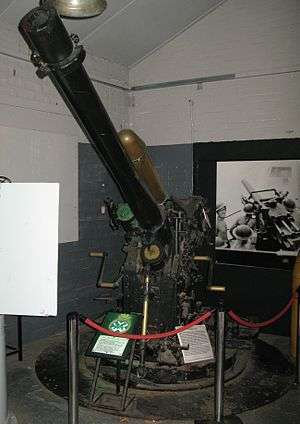HMS Andrew (P423)
| History | |
|---|---|
| Name: | Andrew |
| Builder: | Vickers Armstrong, Barrow-in-Furness |
| Laid down: | 13 August 1945 |
| Launched: | 6 April 1946 |
| Commissioned: | 16 March 1948 |
| Fate: | Sold to be broken up for scrap on 5 May 1977. Scrapped at Plymouth later in 1977. |
| General characteristics | |
| Class and type: | Amphion-class submarine |
| Displacement: | 1,360/1,590 tons (surface/submerged) |
| Length: | 293 ft 6 in (89.46 m) |
| Beam: | 22 ft 4 in (6.81 m) |
| Draught: | 18 ft 1 in (5.51 m) |
| Propulsion: | 2 × 2,150 hp (1,600 kW) Admiralty ML 8-cylinder diesel engine, 2 × 625 hp (466 kW) electric motors for submergence driving two shafts |
| Speed: |
|
| Range: |
|
| Test depth: | 350 ft (110 m) |
| Complement: | 5 officers 55 enlisted |
| Armament: |
|
HMS Andrew (P423), was an Amphion-class submarine of the Royal Navy, built by Vickers Armstrong and launched on 6 April 1946.
The submarine was fitted with a 4-inch (102 mm) deck gun in 1964 for service during the Indonesia–Malaysia confrontation to counter blockade-running junks.[1] The gun was fired for the last time in December 1974.[2] She was sold off in 1977 and was broken up.
Andrew was briefly the oldest Amphion-class submarine to remain in service, was the last British submarine with a deck gun, was the last World War II-designed submarine in service, and was the first submarine to use a "snort" to cross the Atlantic (in May 1953).[3]

Design
Like all Amphion-class submarines, Andrew had a displacement of 1,360 tonnes (1,500 short tons) when at the surface and 1,590 tonnes (1,750 short tons) while submerged. It had a total length of 293 feet 6 inches (89.46 m), a beam length of 22 feet 4 inches (6.81 m), and a draught length of 18 feet 1 inch (5.51 m). The submarine was powered by two Admiralty ML eight-cylinder diesel engines generating a power of 2,150 horsepower (1,600 kW) each. It also contained four electric motors each producing 625 horsepower (466 kW) that drove two shafts.[4] It could carry a maximum of 219 tonnes (241 short tons) of diesel, although it usually carried between 159 and 165 tonnes (175 and 182 short tons).[4]
The submarine had a maximum surface speed of 18.5 knots (34.3 km/h; 21.3 mph) and a submerged speed of 8 knots (15 km/h; 9.2 mph).[5] When submerged, it could operate at 3 knots (5.6 km/h; 3.5 mph) for 90 nautical miles (170 km; 100 mi) or at 8 knots (15 km/h; 9.2 mph) for 16 nautical miles (30 km; 18 mi). When surfaced, it was able to travel 15,200 nautical miles (28,200 km; 17,500 mi) at 10 knots (19 km/h; 12 mph) or 10,500 nautical miles (19,400 km; 12,100 mi) at 11 knots (20 km/h; 13 mph).[4] Andrew was fitted with ten 21 inches (530 mm) torpedo tubes, one QF 4 inch naval gun Mk XXIII, one Oerlikon 20 mm cannon, and a .303 British Vickers machine gun. Its torpedo tubes were fitted to the bow and stern, and it could carry twenty torpedoes. Its complement was sixty-one crew members.[4]
Service history
In September 1950 Andrew sailed to Canada for a three-month deployment training with the Royal Canadian Navy.[6] In February 1953, Andrew deployed to Bermuda for training with the Royal Canadian Navy cruiser Quebec, destroyer Huron and minesweeper Portage.[7] In June 1953, Andrew became the first submarine to cross the Atlantic submerged for the entire voyage, leaving Bermuda and arriving on 15 June in the English Channel. During the voyage a diesel engine was damaged and a periscope malfunctioned, however both were repaired while submerged. The submarine had been returning from its deployment with the Royal Canadian Navy.[8]
Commanding officers
| From | To | Captain | |
|---|---|---|---|
| ? | ~1953 | Lieutenant Commander W.D.S.Scott RN | |
| 1965 | 1966 | Lieutenant-Commander H N M Thompson RN | |
| 1967 | 1968 | Lieutenant Toby Frere RN | |
| 1970 | 1970 | Lieutenant-Commander M J R Tuohy RN | |
References
- ↑ Preston, Antony (2001). The Royal Navy Submarine Service A Centennial History. Conway Maritime Press. p. 129. ISBN 0-85177-891-7.
- ↑ Tall, J.J; Paul Kemp (1996). HM Submarines in Camera An Illustrated History of British Submarines. Sutton Publishing. p. 160. ISBN 0-7509-0875-0.
- ↑ John Lambert and David Hill (1986). The submarine Alliance (Anatomy of the ship series). Conway Maritime Press. p. 19. ISBN 0-85177-380-X.
- 1 2 3 4 Paul Akermann (1 November 2002). Encyclopedia of British Submarines 1901-1955. Periscope Publishing Ltd. p. 422. ISBN 978-1-904381-05-1.
- ↑ "Acheron class". World Naval Ships, Cranston Fine Arts. Retrieved 20 August 2015.
- ↑ "British Submarine Loaned for Training Purposes". The Crowsnest. Vol. 2 no. 11. King's Printer. September 1950. p. 3.
- ↑ "East Coast Ships On Training Cruises". The Crowsnest. Vol. 5 no. 5. Queen's Printer. March 1953. p. 3.
- ↑ "Andrew Sets Undersea Record". The Crowsnest. Vol. 5 no. 9. Queen's Printer. July 1953. p. 3.
Publications
- Colledge, J. J.; Warlow, Ben (2006) [1969]. Ships of the Royal Navy: The Complete Record of all Fighting Ships of the Royal Navy (Rev. ed.). London: Chatham Publishing. ISBN 978-1-86176-281-8. OCLC 67375475.